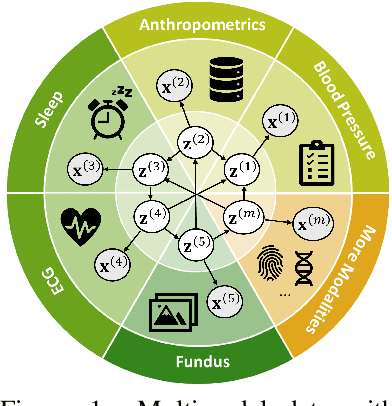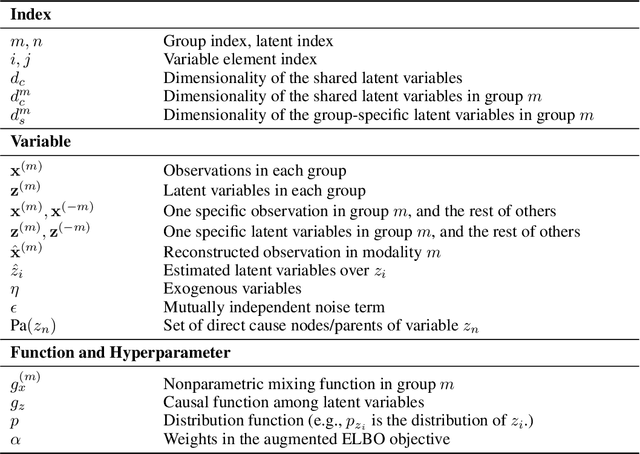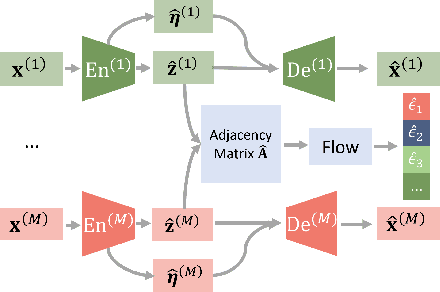Eran Segal
Weizmann Institute of Science, Rehovot, Israel
HPP-Voice: A Large-Scale Evaluation of Speech Embeddings for Multi-Phenotypic Classification
May 22, 2025Abstract:Human speech contains paralinguistic cues that reflect a speaker's physiological and neurological state, potentially enabling non-invasive detection of various medical phenotypes. We introduce the Human Phenotype Project Voice corpus (HPP-Voice): a dataset of 7,188 recordings in which Hebrew-speaking adults count for 30 seconds, with each speaker linked to up to 15 potentially voice-related phenotypes spanning respiratory, sleep, mental health, metabolic, immune, and neurological conditions. We present a systematic comparison of 14 modern speech embedding models, where modern speech embeddings from these 30-second counting tasks outperform MFCCs and demographics for downstream health condition classifications. We found that embedding learned from a speaker identification model can predict objectively measured moderate to severe sleep apnea in males with an AUC of 0.64 $\pm$ 0.03, while MFCC and demographic features led to AUCs of 0.56 $\pm$ 0.02 and 0.57 $\pm$ 0.02, respectively. Additionally, our results reveal gender-specific patterns in model effectiveness across different medical domains. For males, speaker identification and diarization models consistently outperformed speech foundation models for respiratory conditions (e.g., asthma: 0.61 $\pm$ 0.03 vs. 0.56 $\pm$ 0.02) and sleep-related conditions (insomnia: 0.65 $\pm$ 0.04 vs. 0.59 $\pm$ 0.05). For females, speaker diarization models performed best for smoking status (0.61 $\pm$ 0.02 vs 0.55 $\pm$ 0.02), while Hebrew-specific models performed best (0.59 $\pm$ 0.02 vs. 0.58 $\pm$ 0.02) in classifying anxiety compared to speech foundation models. Our findings provide evidence that a simple counting task can support large-scale, multi-phenotypic voice screening and highlight which embedding families generalize best to specific conditions, insights that can guide future vocal biomarker research and clinical deployment.
Improving Diseases Predictions Utilizing External Bio-Banks
Mar 30, 2025Abstract:Machine learning has been successfully used in critical domains, such as medicine. However, extracting meaningful insights from biomedical data is often constrained by the lack of their available disease labels. In this research, we demonstrate how machine learning can be leveraged to enhance explainability and uncover biologically meaningful associations, even when predictive improvements in disease modeling are limited. We train LightGBM models from scratch on our dataset (10K) to impute metabolomics features and apply them to the UK Biobank (UKBB) for downstream analysis. The imputed metabolomics features are then used in survival analysis to assess their impact on disease-related risk factors. As a result, our approach successfully identified biologically relevant connections that were not previously known to the predictive models. Additionally, we applied a genome-wide association study (GWAS) on key metabolomics features, revealing a link between vascular dementia and smoking. Although being a well-established epidemiological relationship, this link was not embedded in the model's training data, which validated the method's ability to extract meaningful signals. Furthermore, by integrating survival models as inputs in the 10K data, we uncovered associations between metabolic substances and obesity, demonstrating the ability to infer disease risk for future patients without requiring direct outcome labels. These findings highlight the potential of leveraging external bio-banks to extract valuable biomedical insights, even in data-limited scenarios. Our results demonstrate that machine learning models trained on smaller datasets can still be used to uncover real biological associations when carefully integrated with survival analysis and genetic studies.
SGAC: A Graph Neural Network Framework for Imbalanced and Structure-Aware AMP Classification
Dec 20, 2024Abstract:Classifying antimicrobial peptides(AMPs) from the vast array of peptides mined from metagenomic sequencing data is a significant approach to addressing the issue of antibiotic resistance. However, current AMP classification methods, primarily relying on sequence-based data, neglect the spatial structure of peptides, thereby limiting the accurate classification of AMPs. Additionally, the number of known AMPs is significantly lower than that of non-AMPs, leading to imbalanced datasets that reduce predictive accuracy for AMPs. To alleviate these two limitations, we first employ Omegafold to predict the three-dimensional spatial structures of AMPs and non-AMPs, constructing peptide graphs based on the amino acids' C$_\alpha$ positions. Building upon this, we propose a novel classification model named Spatial GNN-based AMP Classifier (SGAC). Our SGAC model employs a graph encoder based on Graph Neural Networks (GNNs) to process peptide graphs, generating high-dimensional representations that capture essential features from the three-dimensional spatial structure of amino acids. Then, to address the inherent imbalanced datasets, SGAC first incorporates Weight-enhanced Contrastive Learning, which clusters similar peptides while ensuring separation between dissimilar ones, using weighted contributions to emphasize AMP-specific features. Furthermore, SGAC employs Weight-enhanced Pseudo-label Distillation to dynamically generate high-confidence pseudo labels for ambiguous peptides, further refining predictions and promoting balanced learning between AMPs and non-AMPs. Experiments on publicly available AMP and non-AMP datasets demonstrate that SGAC significantly outperforms traditional sequence-based methods and achieves state-of-the-art performance among graph-based models, validating its effectiveness in AMP classification.
Toward AI-Driven Digital Organism: Multiscale Foundation Models for Predicting, Simulating and Programming Biology at All Levels
Dec 09, 2024



Abstract:We present an approach of using AI to model and simulate biology and life. Why is it important? Because at the core of medicine, pharmacy, public health, longevity, agriculture and food security, environmental protection, and clean energy, it is biology at work. Biology in the physical world is too complex to manipulate and always expensive and risky to tamper with. In this perspective, we layout an engineering viable approach to address this challenge by constructing an AI-Driven Digital Organism (AIDO), a system of integrated multiscale foundation models, in a modular, connectable, and holistic fashion to reflect biological scales, connectedness, and complexities. An AIDO opens up a safe, affordable and high-throughput alternative platform for predicting, simulating and programming biology at all levels from molecules to cells to individuals. We envision that an AIDO is poised to trigger a new wave of better-guided wet-lab experimentation and better-informed first-principle reasoning, which can eventually help us better decode and improve life.
Causal Representation Learning from Multimodal Biological Observations
Nov 10, 2024



Abstract:Prevalent in biological applications (e.g., human phenotype measurements), multimodal datasets can provide valuable insights into the underlying biological mechanisms. However, current machine learning models designed to analyze such datasets still lack interpretability and theoretical guarantees, which are essential to biological applications. Recent advances in causal representation learning have shown promise in uncovering the interpretable latent causal variables with formal theoretical certificates. Unfortunately, existing works for multimodal distributions either rely on restrictive parametric assumptions or provide rather coarse identification results, limiting their applicability to biological research which favors a detailed understanding of the mechanisms. In this work, we aim to develop flexible identification conditions for multimodal data and principled methods to facilitate the understanding of biological datasets. Theoretically, we consider a flexible nonparametric latent distribution (c.f., parametric assumptions in prior work) permitting causal relationships across potentially different modalities. We establish identifiability guarantees for each latent component, extending the subspace identification results from prior work. Our key theoretical ingredient is the structural sparsity of the causal connections among distinct modalities, which, as we will discuss, is natural for a large collection of biological systems. Empirically, we propose a practical framework to instantiate our theoretical insights. We demonstrate the effectiveness of our approach through extensive experiments on both numerical and synthetic datasets. Results on a real-world human phenotype dataset are consistent with established medical research, validating our theoretical and methodological framework.
Generative AI Enables Medical Image Segmentation in Ultra Low-Data Regimes
Aug 30, 2024Abstract:Semantic segmentation of medical images is pivotal in applications like disease diagnosis and treatment planning. While deep learning has excelled in automating this task, a major hurdle is the need for numerous annotated segmentation masks, which are resource-intensive to produce due to the required expertise and time. This scenario often leads to ultra low-data regimes, where annotated images are extremely limited, posing significant challenges for the generalization of conventional deep learning methods on test images. To address this, we introduce a generative deep learning framework, which uniquely generates high-quality paired segmentation masks and medical images, serving as auxiliary data for training robust models in data-scarce environments. Unlike traditional generative models that treat data generation and segmentation model training as separate processes, our method employs multi-level optimization for end-to-end data generation. This approach allows segmentation performance to directly influence the data generation process, ensuring that the generated data is specifically tailored to enhance the performance of the segmentation model. Our method demonstrated strong generalization performance across 9 diverse medical image segmentation tasks and on 16 datasets, in ultra-low data regimes, spanning various diseases, organs, and imaging modalities. When applied to various segmentation models, it achieved performance improvements of 10-20\% (absolute), in both same-domain and out-of-domain scenarios. Notably, it requires 8 to 20 times less training data than existing methods to achieve comparable results. This advancement significantly improves the feasibility and cost-effectiveness of applying deep learning in medical imaging, particularly in scenarios with limited data availability.
From Glucose Patterns to Health Outcomes: A Generalizable Foundation Model for Continuous Glucose Monitor Data Analysis
Aug 20, 2024Abstract:Recent advances in self-supervised learning enabled novel medical AI models, known as foundation models (FMs) that offer great potential for characterizing health from diverse biomedical data. Continuous glucose monitoring (CGM) provides rich, temporal data on glycemic patterns, but its full potential for predicting broader health outcomes remains underutilized. Here, we present GluFormer, a generative foundation model on biomedical temporal data based on a transformer architecture, and trained on over 10 million CGM measurements from 10,812 non-diabetic individuals. We tokenized the CGM training data and trained GluFormer using next token prediction in a generative, autoregressive manner. We demonstrate that GluFormer generalizes effectively to 15 different external datasets, including 4936 individuals across 5 different geographical regions, 6 different CGM devices, and several metabolic disorders, including normoglycemic, prediabetic, and diabetic populations, as well as those with gestational diabetes and obesity. GluFormer produces embeddings which outperform traditional CGM analysis tools, and achieves high Pearson correlations in predicting clinical parameters such as HbA1c, liver-related parameters, blood lipids, and sleep-related indices. Notably, GluFormer can also predict onset of future health outcomes even 4 years in advance. We also show that CGM embeddings from pre-intervention periods in Randomized Clinical Trials (RCTs) outperform other methods in predicting primary and secondary outcomes. When integrating dietary data into GluFormer, we show that the enhanced model can accurately generate CGM data based only on dietary intake data, simulate outcomes of dietary interventions, and predict individual responses to specific foods. Overall, we show that GluFormer accurately predicts health outcomes which generalize across different populations metabolic conditions.
A Multimodal Dataset of 21,412 Recorded Nights for Sleep and Respiratory Research
Nov 15, 2023


Abstract:This study introduces a novel, rich dataset obtained from home sleep apnea tests using the FDA-approved WatchPAT-300 device, collected from 7,077 participants over 21,412 nights. The dataset comprises three levels of sleep data: raw multi-channel time-series from sensors, annotated sleep events, and computed summary statistics, which include 447 features related to sleep architecture, sleep apnea, and heart rate variability (HRV). We present reference values for Apnea/Hypopnea Index (AHI), sleep efficiency, Wake After Sleep Onset (WASO), and HRV sample entropy, stratified by age and sex. Moreover, we demonstrate that the dataset improves the predictive capability for various health related traits, including body composition, bone density, blood sugar levels and cardiovascular health. These results illustrate the dataset's potential to advance sleep research, personalized healthcare, and machine learning applications in biomedicine.
Regularization Learning Networks: Deep Learning for Tabular Datasets
Oct 23, 2018



Abstract:Despite their impressive performance, Deep Neural Networks (DNNs) typically underperform Gradient Boosting Trees (GBTs) on many tabular-dataset learning tasks. We propose that applying a different regularization coefficient to each weight might boost the performance of DNNs by allowing them to make more use of the more relevant inputs. However, this will lead to an intractable number of hyperparameters. Here, we introduce Regularization Learning Networks (RLNs), which overcome this challenge by introducing an efficient hyperparameter tuning scheme which minimizes a new Counterfactual Loss. Our results show that RLNs significantly improve DNNs on tabular datasets, and achieve comparable results to GBTs, with the best performance achieved with an ensemble that combines GBTs and RLNs. RLNs produce extremely sparse networks, eliminating up to 99.8% of the network edges and 82% of the input features, thus providing more interpretable models and reveal the importance that the network assigns to different inputs. RLNs could efficiently learn a single network in datasets that comprise both tabular and unstructured data, such as in the setting of medical imaging accompanied by electronic health records. An open source implementation of RLN can be found at https://github.com/irashavitt/regularization_learning_networks.
Exact Inference in Networks with Discrete Children of Continuous Parents
Jan 10, 2013



Abstract:Many real life domains contain a mixture of discrete and continuous variables and can be modeled as hybrid Bayesian Networks. Animportant subclass of hybrid BNs are conditional linear Gaussian (CLG) networks, where the conditional distribution of the continuous variables given an assignment to the discrete variables is a multivariate Gaussian. Lauritzen's extension to the clique tree algorithm can be used for exact inference in CLG networks. However, many domains also include discrete variables that depend on continuous ones, and CLG networks do not allow such dependencies to berepresented. No exact inference algorithm has been proposed for these enhanced CLG networks. In this paper, we generalize Lauritzen's algorithm, providing the first "exact" inference algorithm for augmented CLG networks - networks where continuous nodes are conditional linear Gaussians but that also allow discrete children ofcontinuous parents. Our algorithm is exact in the sense that it computes the exact distributions over the discrete nodes, and the exact first and second moments of the continuous ones, up to the accuracy obtained by numerical integration used within thealgorithm. When the discrete children are modeled with softmax CPDs (as is the case in many real world domains) the approximation of the continuous distributions using the first two moments is particularly accurate. Our algorithm is simple to implement and often comparable in its complexity to Lauritzen's algorithm. We show empirically that it achieves substantially higher accuracy than previous approximate algorithms.
 Add to Chrome
Add to Chrome Add to Firefox
Add to Firefox Add to Edge
Add to Edge